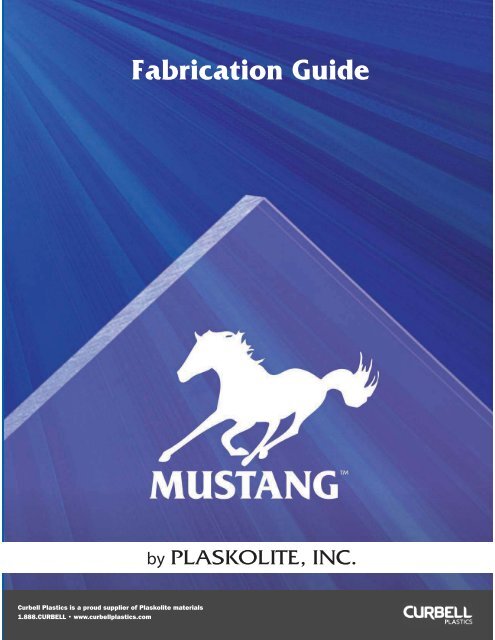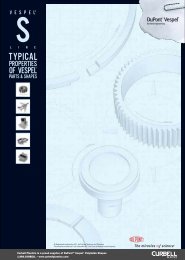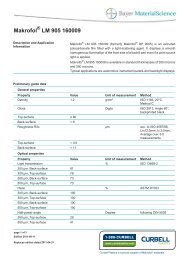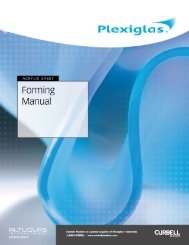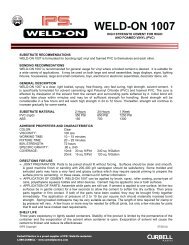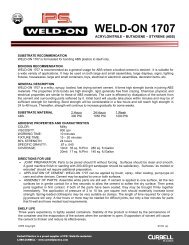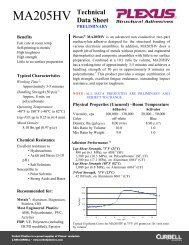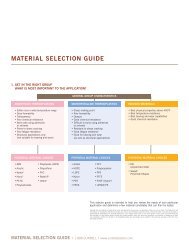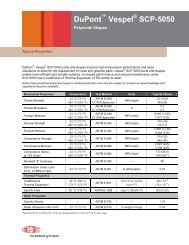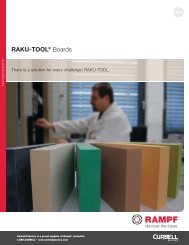Mustang Sheet Fabrication Guide - Curbellplastics.com
Mustang Sheet Fabrication Guide - Curbellplastics.com
Mustang Sheet Fabrication Guide - Curbellplastics.com
- No tags were found...
You also want an ePaper? Increase the reach of your titles
YUMPU automatically turns print PDFs into web optimized ePapers that Google loves.
<strong>Fabrication</strong> <strong>Guide</strong>byCurbell Plastics is a proud supplier of Plaskolite materials
Table of Contents<strong>Mustang</strong> Copolyester<strong>Sheet</strong>Plaskolite is a leading manufacturer of acrylic sheet,acrylic resin, polystyrene sheet, acrylic mirrorsheet products, and <strong>Mustang</strong> copolyester sheet.Since 1950, it has built an excellent reputation forproviding superior quality products and responsivecustomer service.Plaskolite’s <strong>com</strong>mitment to quality extends overevery aspect of its business. From themanufacturing/distribution headquarters inColumbus, Ohio, and manufacturing/distributionfacilities located in Zanesville, Ohio; Compton,California; Grand Saline, Texas; Olive Branch,Mississippi; and Monterrey, Mexico, as well asadditional distribution facilities located in Riverside,California, and Doesburg, Holland, Plaskolitedelivers exceptional quality plastic sheet and resinto its customers worldwide.To better serve customers, sheet can be orderedin customized “run-to-size” dimensions, specialpatterns, and thicknesses. Inside salesrepresentatives use automated order and shippingtracking systems to provide customers with up-tothe-minuteorder information.From manufacturing, through customized productofferings, packing, shipping and order tracking,Plaskolite is <strong>com</strong>mitted to delivering the highestquality products and service.Physical Properties ....................................... 2Features .........................................................2-4Impact Strength ................................................... 2Temperature Resistance ....................................... 3Light Transmission ............................................... 3Weather R esistance .............................................. 3Forming Benefits .................................................. 3Scratch Resistance ................................................ 3<strong>Mustang</strong> <strong>Sheet</strong>/Sign Grade PolycarbonatePhysical Properties ............................................... 4Care ................................................................... 5Safety C oncerns ................................................... 5Storage ................................................................ 5Handling .............................................................. 5Masking Removal ................................................ 5Cleaning .............................................................. 5Cutting/Machining .....................................5-9Cutting .............................................................5-6Drilling ................................................................. 7Cutting and Drilling Tips ...................................... 7Edge Finishing ..................................................... 7Bonding <strong>Mustang</strong> to Itself .................................... 7Adhering <strong>Mustang</strong> to Other Materials .................. 8Mechanical Fastening ........................................... 8Decorating ........................................................... 8Paint R emoval ...................................................... 9Vinyl Films ........................................................... 9Vinyl Weeding ..................................................... 9Forming .......................................................9-11Cold B ending ....................................................... 9Brake Bending ..................................................... 9Line Bending ..................................................... 10Oven Heating .................................................... 10Thermoforming .................................................. 10Free Blown Forming ........................................... 11Availability and Transportation ........................... 11Forming and Annealing ..................................... 11Selection of <strong>Sheet</strong> Thickness .............................. 11<strong>Sheet</strong> S ize .......................................................... 11Sign Assembly .............................................. 12Assembly .......................................................... 12Ventilation ......................................................... 12Attachment of Trim Cap ..................................... 12Chemical Resistance .................................. 13Troubleshooting <strong>Guide</strong> .........................14-15Suggested Vendors ..................................... 16Disclaimer ..................................................... 171
<strong>Mustang</strong> FeaturesTemperature Resistance<strong>Mustang</strong> sheet begins to soften between210-215º F. This allows for ease in thermoformingand <strong>com</strong>patibility with sheet pre-decorated withvinyl and/or paint. In sheet form, it can withstandtemperatures down to -30º F without anynoticeable changes in impact properties 1It has a heat distortion temperature equivalentto that of acrylic sheet, making it ideal foroutside applications.Light Transmission<strong>Mustang</strong> sheet has a light transmission of 89% anda haze of 1% or less.Weather Resistance<strong>Mustang</strong> sheet is re<strong>com</strong>mended for indoor oroutdoor applications. Manufactured with provenUV protective layer technology, which providesexcellent weatherability and filtering of damagingwavelengths in the area of 250 –390 nanometers(See Graphs 2 & 3). The masking on the sheet sidewith the UV protective layer is clearly labeled andshould always be fabricated to face the sun in thefinished application. Discoloration of plasticcan also be caused from atmosphericcontamination and particles, this damaging effectcan be minimized by regular cleaning of thefinished product.Forming Benefits<strong>Mustang</strong> sheet has a wide thermoforming windowand is exceptionally easy to form. Compared topolycarbonate, it has shorter heating and coolingcycles, better forming detail, improved materialdistribution, and much better <strong>com</strong>patibility withvinyl and paint. Due to the low temperaturerequired to thermoform, and the shorter heatingand cooling cycle times, <strong>Mustang</strong> sheetpre-decorated with vinyl and/or screen inkscan be easily formed.<strong>Mustang</strong> sheet does not require pre-drying,which allows for significant savings in energy,labor and production costs.Scratch ResistanceThe scratch resistance of <strong>Mustang</strong> sheet is notas high as acrylic but is <strong>com</strong>parable to that ofpolycarbonate. Care should be used when handlingthe sheet during the fabrication process.It is re<strong>com</strong>mended that the protective maskingremain on the sheet as long as possible.100<strong>Mustang</strong> UV Transmittance Data100Polycarbonate UV Transmittance Data9080<strong>Mustang</strong> with no UV cap layer<strong>Mustang</strong> with UV cap layer9080Polycarbonate with no UV cap layerPolycarbonate with UV cap layerPercent Transmittance7060504030Percent Transmittance7060504030202010100200 250 300 350 400 450 500Wavelength, nm0200 250 300 350 400 450 500Wavelength, nmGraph 2 Graph 31ASTM D3763 - High Speed Puncture Properties of Plastics3
<strong>Mustang</strong> CareSafety Concerns<strong>Mustang</strong> sheet, like other thermoplastic sheetmaterials, is <strong>com</strong>bustible. Do not place or store inor near open fl ame or other sources of ignition.Always consider fire precautions when workingwith thermoplastic sheet materials.StorageIt is re<strong>com</strong>mended that <strong>Mustang</strong> sheet bestored horizontally, on the supplied fl at bulkskids, in a well-ventilated, constant temperatureenvironment. Avoid storing in areas where thetemperature could exceed 100° F.A-frames or special racks can be used to store thesheet vertically. The rack construction should allowthe sheet to lean approximately 10°.Handling<strong>Mustang</strong> sheet is covered with a film masking,providing minimal scratch protection to the sheetsurface area. Care should be taken when handling,as wood surfaces, dirt, chips of wood, and metalcan tear the masking exposing the sheet topossible damage.Masking RemovalThe protective masking can be easily removed.Start at a corner and peel back at an approximate45º angle. The buildup of static charge is possible,and may cause small shocks to the personremoving the masking. Wiping the surface area ofthe sheet with a damp cotton cloth can reduce theamount of static charge.Cleaning<strong>Mustang</strong> sheet, like all plastics used in sign faces,needs to be and should be cleaned periodically(1-2 times/year). A regular cleaning programwill help minimize any visible weathering ofthe sign face from dirt, grime, rain, and othernatural elements.For general cleaning, it is re<strong>com</strong>mended thatthe following instructions be used:1 Rinse sheet with lukewarm water.2 Wash sheet with a mild solution of liquid dish detergent in water.3 Use a soft cotton cloth to gently wash the sign face.4 Rinse thoroughly with clean cold water.5 Avoid the use of abrasive cleaners, squeegees and/or othercleaning implements that may mar or gouge the sheet.For more heavily weathered sign faces, rinse first,then use Formula 409 ® with a soft cotton cloth,then rinse with clean water to remove the cleaningagent as quickly as possible.The following cleaning products have beenfound to be <strong>com</strong>patible with <strong>Mustang</strong> underlaboratory conditions.*Joy ® VM&P Naphtha ®Palmolive ® Liquid Windex ®Lemon Cascade ® Soft Scrub ®Isopropyl Alcohol (mixed 1:1 with clean water)* Plaskolite cannot guarantee that actual end-use conditions havebeen duplicated. Therefore, these results should be used as a guideonly and it is re<strong>com</strong>mended that the products be tested underactual end-use conditions by the user. When using these products,do not allow them to remain on the sign face longer than it takes toremove the dirt, grime, or other deposits. Immediately remove thecleaning agent with a soft clean cotton cloth.Cutting/MachiningCuttingBecause of its excellent strength and fl exibility,<strong>Mustang</strong> sheet cannot be broken using a scribeand break technique. It must be cut <strong>com</strong>pletelythrough. Cutting can be done with a variety ofdevices such as table and panel saws, circularsaws, jig or saber saws, band saws, table andhand routers, CNC routers, and roto-zip tools.If <strong>Mustang</strong> sheet chips or cracks during thecutting and trimming process, it is most likelydue to worn, dull blades and bits. Always useclean, sharp cutting equipment and make sure thesheet being cut is adequately secured to preventvibrations of the sheet during the cutting process.Table and panel saws are the best options forhigh volume straight cuts. <strong>Mustang</strong> sheet can bestacked to cut several sheets at one time, but thestack must be held securely to prevent movement.When cutting, the saw blade should protrudethrough the top of the sheet 1/8"-1/4"(See Figure 1). Saw blades specifically designed forcutting plastic sheet are <strong>com</strong>mercially available.Those with triple chip grind teeth are preferred.(See Figures 2-3).5
Cutting/MachiningBlade Diameter (in/mm)6 (152)7.25 (180)8 (200)10 (250)12 (300)14 (350)RPM640050004300340029002500Circular Saw Blade SpecificationsNumber of teeth3-4/inch (25mm) >1/8" (3mm)thicknessFigure 18-10/inch (25mm) < 1/8" (3mm)thicknessFigure 2ClearanceangleRakeRouting is a versatile method for cutting andtrimming <strong>Mustang</strong> sheet. Bit selection is importantand those specifically designed for plastics are<strong>com</strong>mercially available. Carbide bits with sharp oneto two fl uted designs work very well. The numberof fl utes depends on the diameter of the bit andthe speed (rpm) of the router. In general, use singlefl uted carbide tipped bits for bit diameters 3/8"and double fl uted carbide tipped bits for largerbit diameters.Chipping and cracking of the sheet edges can occurif the correct router settings are not observed. Thismay be detrimental to the physical properties ofthe sheet. Please see the Troubleshooting <strong>Guide</strong> onpage 15 for additional information.Figure 3Carbide teethOther Types of SawsBand Saws: Use blades with 8-14 teeth/inch forgeneral cutting: 18-25 teeth/inch when smoothercuts are necessary.Saber or Jig Saws: Use blades with 8-10 teeth/inch. Ensure that your sheet material is securelyfastened to prevent vibration during thecutting process.Kett Saws: Blade #157-66, 2.5" diameter, 60teeth. Rate of cut will determine quality of cut.Roto-Zip Type: ZB10 bit for small trim of 0.150"sheet. For thicker sheet, use Onsrud #52-624.6
Cutting/MachiningDrillingDrilling holes is performed best on a drill presswith <strong>com</strong>mercially available plastic cutting drillbits. The bit diameter should be used to determinethe appropriate drill speed (See Table 1).Bit Diameter(inches)1/83/161/43/81/25/8Table 1Speed(RPM)3500250018001200900700Standard‘Twist Drill BitFigure 460-90°ModifiedDrill BitGrind smallflats along thecutting edgePlace a scrap piece of plastic sheet or plywoodunder the sheet that is being drilled. This willeliminate the possibility of chipping as the bitpasses through the other end. Standard twist drillscan be used, provided modifications to the drill bitare made. These modifications will allow the bitto scrape rather than cut through the sheet (SeeFigure 4).Regulate the speed of drilling to obtain acontinuous spiraling chip. Use air or a cool watermist spray if needed. Avoid cutting oils as theymay cause crazing around the drilling area. Refrainfrom creating notches in the drilled areas asnotches and crazing may cause premature failureof the sheet or fabricated part.Cutting and Drilling TipsFor optimum cutting and drilling quality, the belowguidelines should be observed:• Use sharp blades/bits/tools reserved for cuttingplastic sheet• Use proper and constant feed rates and RPMs• Prolong tool life by using the fastest rate of cutto achieve the desired edge or cut quality• Always clamp the sheet being fabricated toeliminate vibration which could possibly causechipping or cracking during cutting/drilling• Compressed air or a fine water mist may be usedif necessary to minimize heat buildup during thecutting and trimming processesEdge FinishingWhen edge finishing is required, mechanical edgefinishing with diamond cutting wheels provideexcellent results. If further edge quality is required,fl ame polishing may be the preferred technique(remove masking prior to fl ame polishing).Bonding <strong>Mustang</strong> to ItselfTwo-part adhesives are re<strong>com</strong>mended whenbonding <strong>Mustang</strong> to <strong>Mustang</strong>. Solvent bondingsimilar to the technique used when bonding acrylicparts is not re<strong>com</strong>mended. There are severaladhesives that have been found to work well with<strong>Mustang</strong> sheet. The following have been evaluatedand work well with <strong>Mustang</strong> sheet. In order ofeffectiveness:• Weld-On #55• Lord Adhesives #7542 A/B• Flex Welder 14345• Lord Adhesives #403/19• Lord Adhesives #406/19• Lord Adhesives #406/17• Plastic Welder II #14340• Cybercryl #812• Weld-On #58Two-sided pressure sensitive tapes such as 3MVHB bonds well to <strong>Mustang</strong>.7
Cutting/MachiningAdhering <strong>Mustang</strong> to Other MaterialsCare should be taken when bonding <strong>Mustang</strong> toother materials. Slight differences in thermalexpansion and contraction characteristics couldplace a large concentrated stress on the bondedarea. If <strong>Mustang</strong> must be bonded to dissimilarmaterials, bond as small an area as possible usingadhesives that remain fl exible after curing.Below are re<strong>com</strong>mended adhesives forbonding <strong>Mustang</strong> to other materials. In order ofeffectiveness:<strong>Mustang</strong> to PolycarbonateLord 7542 A/BWeld-on #58Loctite 3922Loctite 3321Loctite 3106Dymax 3094Lord 406/19Dymax 3015Plastic Welder II #14340The adhesives listed for <strong>Mustang</strong> to <strong>Mustang</strong>,and for bonding <strong>Mustang</strong> to other materials, havebeen evaluated and are re<strong>com</strong>mended. For bestresults, please follow the guidelines for use fromthe adhesive manufacturers.Mechanical Fastening<strong>Mustang</strong> to AcrylicLord 403/19Lord 406/19Loctite 3922Loctite 3106Loctite 3321Dymax 3094Lord 7542 A/BBondmaster V5004Attaching <strong>Mustang</strong> sheet to itself and othersubstrates can be ac<strong>com</strong>plished with varioustypes of mechanical fasteners. However, whenexposed to fluctuating temperatures, allowancesfor expansion and contraction must be included.Drilling oversized holes, using rubber-coatedwashers and spacers to distribute localized stressand to act as a cushion to the fastener, as well asnot overtightening the fasteners, will allow thesheet to move and assist in the prevention ofpremature failure at the bonded area. Use onlynon-rusting fasteners, such as aluminum pop rivets,and space the mechanical fasteners far enoughapart to avoid localized overstressing inthe attached area, but still close enough to carrythe expected load.Decorating<strong>Mustang</strong> sheet can easily be decorated using signpaints manufactured for use on plastics. Followthe paint manufacturer’s guidelines for optimumresults. Always use proper fabrication guidelinesprior to painting and make sure that the <strong>Mustang</strong>sheet is clean of dust, dirt, grease, oily residues,and grime. All of these will affect the level of paintadhesion and the performance of the finishedproduct. A 1:1 mixture of water and isopropylalcohol works well for the oily residues that areresistant to mild soapy water. Use a soft cottoncloth to rub lightly and dry.<strong>Mustang</strong> sheet works exceptionally well inpre-decorated applications where thermoformingis necessary. Because pre-drying isn’t required,the lower thermoforming temperatures, improvedmaterial distribution and stretching characteristics,<strong>Mustang</strong> sheet is fully <strong>com</strong>patible with vinyland screen inks that are designed forthemoformed signs.When using the spray and cut maskingtechnique, care should be taken not to cut the<strong>Mustang</strong> sheet surface when cutting throughthe masking. This could cause notches, whichmay result in premature failure of the sheet orfabricated part. It is suggested that the blade tipof the cutting instrument be rounded to preventaccidental notching.Paint typically reduces the impact strength of allplastics. Design considerations should be taken intoaccount to minimize the potential for cracking andpossible breakage of the finished part.General guidelines include:• Avoid too wet a mist when spraying• Allow proper drying time between coatsof paint (refer to paint manufacturer’sre<strong>com</strong>mendations)• Avoid application of heavy wet coats of paintduring each application• Use dry air during the spraying process aswater can affect the adhesion and strengthof the paint film• Avoid high humidity areas during the paintcuring process8
Cutting/Machining• Do not blend paints from different manufacturers• Do not use an overly thick layer of paint to obtainopacity. It is better to use several thin layers toachieve this resultPaint RemovalWhen paint removal is required, remove as soon afterpainting as possible. A paint thinner may be used;however, review the paint manufacturer’sre<strong>com</strong>mendations prior to applying. Always minimizethe time solvents are in contact with plastic sheet.Vinyl FilmsLettering and intricate designs made with vinyladhere well to <strong>Mustang</strong> sheet. They can be appliedeither wet or dry, depending on the preference ofthe operator. Due to the low temperature requiredto thermoform, the stretching characteristics, and<strong>Mustang</strong>’s overall thermoforming superiority toother plastic materials, a sheet pre-decorated withvinyl can be thermoformed for distortion formingapplications. The unique process of forming apre-applied vinyl on the second surface is anoption with <strong>Mustang</strong>, with the only limitationbeing the vinyl’s ability to stretch. This processis not done on other sign plastics.Vinyl Weeding<strong>Mustang</strong> sheet is an excellent material for vinyldecoration, both prior to and after thermoforming.As with other plastics, the sheet needs to dryovernight to allow the moisture to escape frombetween the <strong>Mustang</strong> and the vinyl. If using multiplelayers of vinyl decoration, additional time maybe required.The thermoforming temperatures for <strong>Mustang</strong> are<strong>com</strong>patible with those of vinyl, allowing more evenvinyl stretching characteristics and less chance ofvinyl blistering.Use caution when removing (weeding) the excessvinyl from a pre-decorated, thermoformed sign face.The below steps are suggested when using andweeding vinyl from a formed face:• Apply vinyl per the manufacturer’sre<strong>com</strong>mendations• Generally, it is best to weed vinyl as soon afterforming as possible• Allow <strong>Mustang</strong> sheet to cool a minimum of 1hour to room temperature prior to weeding• Do not allow the knife used to weed penetratethe surface of <strong>Mustang</strong>• Once the weeding process has begun, pull thevinyl in smooth, even motions. Removing toorapidly could cause the vinyl to tear• Use both hands to pull the vinyl from <strong>Mustang</strong> atan approximate 70-80 degree angle. Pulling ata 45 degree angle is more difficult and increasesthe chance of vinyl tearingSecond Surface Vinyl Weeding• When applying and thermoforming second surfacevinyl (applied to the non UV side of the sheet), thevinyl must be weeded before it cools <strong>com</strong>pletely.Complete cooling generally occurs within 5-10minutes after forming. Ideally, weeding shouldtake place as soon as the vinyl has the integrityto do so.• If weeding the second surface vinyl isn’t possibleprior to <strong>com</strong>plete cooling, reheat the area ofvinyl where weeding is necessary using a smallhand-held propane torch, using the “fanning”attachment. Take care not to burn or blister thevinyl during this process.FormingCold BendingAlthough no plastic sheet should be cold bent toany severity, a bend in <strong>Mustang</strong> can be achievedwithout applying heat. A minimum radius of atleast 100 times the initial thickness of the sheetis required.Brake BendingBrake bending is not re<strong>com</strong>mended whenfabricating plastic sheet. However, if this typeof fabrication is necessary, do not perform on<strong>Mustang</strong> sheet >0.100" (2.5mm) thickness.Heat bending should be used on thicker gauges.Brake bending creates high levels of stress in thebend area, and could result in cracks and breakageduring this process, or at a later time.9
FormingLine BendingLine bending, also known as strip heating, is atechnique used for forming sharp bends in theplastic sheet. When heated properly, <strong>Mustang</strong> lendsitself well to this type of fabrication. The radius ofthe bend can be controlled by the width of theheated area. The temperature of the side oppositeof the heat source should be heated to ≥250° Fprior to bending. This will assist in eliminating theresidual stress that can form when bending at atemperature that is too cold. Thicker sheets shouldbe heated from both sides to achieve a uniformheating through the sheet. Heat perpendicular tothe manufacturer’s extrusion direction to reduce thepossibility of warpage in the heated areas. Alwaysstabilize the sheet by clamping during the heatingand cooling processes.Oven Heating<strong>Mustang</strong> sheet should be heated in a horizontaloven. It is not conducive to use with vertical ovens.ThermoformingThe term thermoforming refers to the processof heating a plastic sheet to sufficient temperature toform a shaped article. <strong>Mustang</strong> sheet excels in thisarea, offering a unique <strong>com</strong>bination unmatched bypolycarbonate. <strong>Mustang</strong> sheet can be thermoformedwithout pre-drying, forms at lower temperatures,has faster heating and cooling cycles, has excellentmaterial distribution characteristics and processesconsistently. Deep draws and intricate part definitionsare achievable with <strong>Mustang</strong> by using simple vacuumforming techniques.The entire cut to size sheet is typically heated toforming temperature inside an oven. The formingtemperature depends on the thickness of the sheetand the shape or <strong>com</strong>plexity of the mold (See Table2). For less intricate molds, heat <strong>Mustang</strong> sheet onthe lower side of the temperature range. For deeperdraws and more <strong>com</strong>plicated mold designs, heat tothe middle to upper side of the temperature range.Because <strong>Mustang</strong> sheet exhibits great detail, careshould be taken when manufacturing the mold. Itneeds to be smooth. <strong>Mustang</strong> sheet will form to thedetails of a rough mold (mold mark-off).The radii of the finished part should be greater thanor equal to the initial sheet thickness. This willgreatly reduce stress molded into the part due tosharp radii (See Figure 5). Sharper corners increasethe localized stress, which could lead to micro cracks,and then to possible part failure.During the cooling process, a thermoformed partshould be fully supported as additional shrinkagemay occur. The extrusion direction of the sheet is themost susceptible to shrinkage. Supporting will reducethe possibility of warping of the final part, especiallyin the flange area.Thermoforming Temperature vs <strong>Sheet</strong> Thickness<strong>Mustang</strong> Thermoforming Conditions: 0.118 to 0.177 thicknessPropertyOptimal Forming Temperature Range (ºF)Optimal Forming Temperature (ºF)Heating Time with One Sided Heating OvenMolded Part Release Temperature (ºF)Optimal Mold Temperature (ºF)Typical shrinkage factorsMDTD0.118310-3403254-5 minutes180-185180
FormingStresses Created Compared to Radiusof CornersStress-Concentration Factor3.53.02.52.01.51.0Figure 5Free Blown FormingThis is done by clamping the heated <strong>Mustang</strong>sheet and blowing upward with <strong>com</strong>pressedair similar to blowing a bubble. The reverse canbe ac<strong>com</strong>plished by drawing the sheet into achamber using vacuum pressureAvailability and Transportation<strong>Mustang</strong> is available in fl at sheet or roll stock. Ifcutting from reels, do not re-roll to less than 50"diameter. <strong>Sheet</strong> should be handled standing onedge. Protect the entire sheet from scratches withshrink wrap or other protective source.Forming and Annealing<strong>Mustang</strong> sheet cut from reels can be thermoformedwithout annealing. However, if a flat sign will bemanufactured from <strong>Mustang</strong> cut from rollstock,annealing is re<strong>com</strong>mended. Annealing can beac<strong>com</strong>plished by placing the sheet in a forced airoven at 165º F for 2-3 hours and allowing it to coolto at least 120º F prior to use.Uniform Load Apprroximate Wind Velocity20 PSF75 MPH30 PSF90 MPH40 PSF100 MPH50 PSF130 MPHTable 3Stress-Concentration FactorForceWall ThicknessRadius0 0.2 0.4 0.6 0.8 1 1.2 1.4Radius/ThicknessSelection of <strong>Sheet</strong> ThicknessDetermining proper sheet thickness is based onthe short dimension of the sign and the specifiedmaximum wind load in pounds per square feet(PSF) (see Figure 6). The sign is required to meet aspecified wind load determined by building codesof your area. Approximate wind loads in relation towind velocity can be seen in Table 3.Short Dimensions (inches)1009080706050403020Figure 61/2"3/8"1/4"3/16"0 5 10 15 20 25 30 35 40 45 50Uniform Load, PSF<strong>Sheet</strong> SizeExpansion and contraction allowances must betaken into consideration when fabricating signsfor outdoor applications. <strong>Mustang</strong> sheet, like allplastics, must be allowed to move within theconfinements of the sign channels to preventbowing or dislodging. The coefficient of linearthermal expansion (COTE) is 3.9 x 10 -5 .This number can be used to calculate thenecessary dimensions needed to allow thenecessary movement of the plastic sign face.A simple rule of thumb is to allow 1/16" perlinear foot in each direction (width and height).11
Chemical ResistanceChemical Resistance of <strong>Mustang</strong> Copolyester <strong>Sheet</strong>Resistant (Compatible)Acetic Acid (5%)Oleic AcidMethyl AlcoholAmmonium Hydroxide (sg .9)Mineral OilLipid Solution (2%)Hydrogen Peroxide (3%)Ammonium Hydroxide (10%)PhthalateEthyl Alcohol (50%)Diesel FuelHeptaneHydrogen Peroxide (28%)KeroseneNitric Acid (40%)Transmission FluidDetergent Sol. (.025%)Transformer OilDistilled WaterCottonseed OilCitric Acid (1%)TurpentineSoap Solution (1%)IsopropanolMotor OilOlive OilSod Carb Sol. (20%)Nitric Acid (10%)IsooctaneEthyl Alcohol (95%)Brake FluidAntifreezeNon-Resistant (Not Compatible)Ethylene DichlorideTolueneAnilineEthyl AcetateAcetoneDimethyl FormamideDiethyl EtherPhenol Solution (5%)Acetic Acid (sg 1.05)Gasoline13
Troubleshooting <strong>Guide</strong><strong>Mustang</strong> Thermoforming TroubleshootingProblemCrazed, crackedor brittle partsWebbing during formingprocessNon-uniform sheet sagPoor material distributionPoor detail or partdefinitionPoor surface finish/defects/pin-holingSticking to moldVoids or bubbles in sheetPart warpageMaterial pulling fromframesTrimming difficultiesChipping/crackingduring cuttingPossible Cause• Poor mold design• <strong>Sheet</strong> forming temp. too low• <strong>Sheet</strong> too hot• Complex mold design• Rate of vacuum too fast• Uneven heating of sheet• Poor mold design• Poor mold layout• Uneven oven heating• Uneven oven heating• Uneven clamp pressures• Deep drawn parts• <strong>Sheet</strong> too cold• Poor mold design• Insufficient vacuum• Uneven sheet temperatures• Vacuum release too soon• External cooling applied too soon• Dirty mold• Mold surface defects• Vacuum holes too large• Vacuum rate/amount too high• Mold mark-off• Draft angle too small• Radii too small• Mold too hot• <strong>Sheet</strong> too hot• Excessive sheet moisture• Insufficient cooling of part• Mold too cold• <strong>Sheet</strong> too cold• Insufficient/uneven clamp pressure• Improper blade selection• Incorrect blade speed• Inadequate clamping of parts• Saw blade tooth gap too large• Dull blade or shearSuggested Solutions• Increase mold radii to equal sheet thickness• Increase heat settings and/or time in oven• Decrease sheet temperature• Use female mold design• Use plug and or pressure assisted forming• Decrease rate and time of applied vacuum• Check oven heaters for “hot spots” or bad elements• Increase radii and draft angles• Spacing between molds should be approximately 2” x depthof draw or height of molded part• Check oven heaters and adjust accordingly• Check for colder air drafts around forming area• Check oven heaters and adjust accordingly• Check for air drafts around forming area• Check clamp pressures and adjust• Use plug or pressure assist• Increase sheet temperature• Increase radii, draft angles, spacing, etc• Check vacuum pumps, increase if necessary• Check oven heaters and adjust, Check for air drafts• Increase timing to vacuum release• Increase time prior to external cooling application• Clean mold with air/damp dust free cloth• Sand and/or polish mold surface• Decrease size of vacuum holes• Decrease rate and/or amount of vacuum• Vapor hone or lightly sand mold surface• Increase draft angle >= 5°• Increase radii to equal sheet thickness• Reduce mold temperature if possible• Use talcum powder to dust mold• Decrease heating time and/or oven temperature• Increase distance from heating elements• Dry sheet @ 80 °C, 2-4 hours• Store sheet under dry conditions (inside)• Allow part to cool longer prior to mold release• Wait longer time prior to cooling fan activation after forming• Increase mold temperature to allow slower cooling• Increase sheet temperatures• Increase/equilibrate clamp pressures• Routers: Slotting cutter, carbide tipped, 0.062 decimal kerf,4-wing (i.e. Whiteside Part# 6700B)• Table Saws: See Table Saw section - pages 5 & 6• Band Saws: See Band Saw section - page 6• Routers: Use 20-25,000 RPM Router speed• Increase/equilibrate clamp pressure• Choose blade with more teeth/inch• Replace blade/sharpen shear14
Troubleshooting <strong>Guide</strong><strong>Mustang</strong> Circular Saw TroubleshootingProblem Possible Cause Suggested SolutionsSoftened edges• Blade speed too fast• <strong>Sheet</strong> feed rate too slow• Blade tooth size too small• Blade too hot• Dull blade• Too many sheets in cutting stack• Reduce blade speed• Increase sheet feed rate• Increase blade tooth size• Use cool air on blade duing cutting• Sharpen blade• Reduce the of sheets in cutting stackChipping of sheet• <strong>Sheet</strong> is not properly clamped• <strong>Sheet</strong> feed rate too fast• Dull blade• Blade is not installed properly• Blade tooth size is too large• Clamp sheet securely to minimize vibrations• Reduce sheet feed rate• Sharpen blade• Ensure blade is properly installed and free of wobble• Reduce blade tooth size15
Suggested VendorsAdhesive ManufacturerIPS Corporation(800) 421-2677455 West Victoria StreetCompton, CA 90220www.ipscorp.<strong>com</strong>Lord Corporation(877) 275-56732000 West Grandview Ave.Erie, PA 16514www.lord.<strong>com</strong>Dymax Corporation(860) 482-1010318 Industrial LaneTorrington, CT 06790www.dymax.<strong>com</strong>Henkel Loctite Corporation(800) 562-84831001 Trout Brook CrossingRocky Hill, CT 06067www.henkel.<strong>com</strong>ITW Devcon(800) 626-722630 Endicott StreetDanvers, MA 01923www.devcon.<strong>com</strong>National Adhesives(800) 797-492210 Finderne AvenueBridgewater, NJ 08807www.nationaladh.<strong>com</strong>Paint/Ink ManufacturerAkzo-Nobel, Inc.(770) 662-84643669 Old Peachtree RoadNorcross, GA 30071www.akzonobel.<strong>com</strong>Coates Screen, Inc.(630) 513-53482445 Production DriveSt. Charles, IL 60174www.sunchemical.<strong>com</strong>Spraylat Corporation(800) 336-1936716 South Columbus Ave.Mt. Vernon, NY 10550Nazdar(913) 422-18888501 Hedge Lane TerraceShawnee, KS 66227ProductWeld-On #55Weld-On #58Lord 7542 A/BLord 403/19Lord 406/17Lord 406/19Dymax 3094Dymax 3015Loctite 3922Loctite 3321Loctite 3106Plastic Welder II #14340Bondmaster V5004ProductSuper GripflexSeries T-2003thinnerVAC Series UV curedscreen inks C37 Seriessolvent cured screeninks HG-501 screen inks305 meshPaint-White: Lacryl C5-1972Others: Lacryl 400 SeriesThinners: Lacryl 205TScreen inks-Lacryl 800 SeriesScreen inks-Solvent cure: 9700 SeriesUV cure: 1500 SeriesSaw Blade ManufacturerFS Tool Corp.(800) 387-9723P.O. Box 510210 S. 8th StreetLewiston, NY 14092www.fstoolcorp.<strong>com</strong>General Saw Corp.(800) 772-36912518 Andalusia Blvd.Cape Coral, FL 33909www.generalsaw.<strong>com</strong>Forrest Mfg. Co. Inc.(800) 733-7111457 River RoadClifton, NJ 07014www.orestblades.<strong>com</strong>Router Bit ManufacturerOnsrud Cutter(800) 234-1560800 Liberty DriveLibertyville, IL 60048www.onsrud.<strong>com</strong>Amana Tool Corp.(800) 445-0077120 Carolyn Blvd.Farmingdale, NY 11735www.amanatool.<strong>com</strong>Saber Diamond Tools Inc.(888) 240-4324101 Saber ParkwayVilla Rica, GA 30180www.saberdiamond.<strong>com</strong>Drill Bit ManufacturerOnsrud Cutter(800) 234-1560800 Liberty DriveLibertyville, IL 60048www.onsrud.<strong>com</strong>Thermoforming Equipment ManufacturerPlastiVac, Inc.(800) 432-6328214 Dalton Ave.P.O. Box 5543Charlotte, NC 28299www.plastivac.<strong>com</strong>The Shuman Company3232 South BoulevardCharlotte, NC 28209These suggested vendors and their products are based on information we believe to be reliable. They are offered in good faith, butwithout guarantee, as conditions and methods of use of the products are beyond our control. We re<strong>com</strong>mend that the prospectiveuser determine the suitability of our material with the products of the vendors, prior to adopting them on a <strong>com</strong>mercial scale.16
DisclaimerThis manual is a general guide for working with MUSTANG Copolyester <strong>Sheet</strong>. Because actual resultsvary with differences in operating conditions, thickness, color, and <strong>com</strong>position of the copolyester sheet,nothing contained herein can be construed as a warrant that MUSTANG will perform in accordance withthese general guidelines.Important Notice: Our re<strong>com</strong>mendations, if any, for the use of this product, are based on tests believed tobe reliable. The greatest care is exercised in the selection of raw materials and in the manufacturingoperations. However, since the use of this product is beyond the control of the manufacturer, no guaranteeor warranty expressed or implied is made as to such use or effects incidental to such use, handling orpossession of the results to be obtained, whether in accordance with the directions, or claimed so to be.The manufacturer expressly disclaims responsibility therefore. Furthermore, nothing contained herein shallbe construed as a re<strong>com</strong>mendation to use any product in confl ict with existing laws and/or patents coveringany material or use.Anyone experiencing problems fabricating MUSTANG Copolyester <strong>Sheet</strong> should refer those questions tothe Plaskolite Inside Sales Department at (800) 848-9124.This manual does not constitute an offer to sell by Plaskolite. Plaskolite sells ONLY under its current Termsand Conditions of Sale, which appear on its Acknowledgements and invoices. A current copy of Plaskolite’sTerms and Conditions of Sale will be supplied upon request. The details provided are believed to be accurateat the time of publication; however, no description of warranty that the product is suitable for any particularapplication. PLASKOLITE MAKES NO WARRANTIES, AND UNDERTAKES AND ACCEPTS NO LIABILITIES,EXCEPT ONLY AS SET FORTH IN ITS CURRENT TERMS AND CONDITIONS OF SALE.© 11/2008 Plaskolite, Inc. All Rights Reserved. Printed in the USA.MUSTANG is a trademark of Plaskolite, Inc.Eastman and Tritan are trademarks of Eastman Chemical CompanyMUSTANG sheet is manufactured with17
Curbell Plastics is a proud supplierof Plaskolite materialsNationwide1.888.CURBELLwww.curbellplastics.<strong>com</strong>Plaskolite is a leading manufacturer of Optix ® continuously processed acrylic sheet,Duraplex ® impact modifi ed acrylic sheet, acrylic resin, polystyrene sheet, Fabback ®acrylic mirror sheet and <strong>Mustang</strong> copolyester sheet.<strong>Mustang</strong> sheet is manufactured with Eastman Tritan copolyester resin, which isGREENGUARD certifi ed. Eastman Tritan has been tested to stringent indoor emissiontesting requirements and was found to be a very low-emitting material. GREENGUARDproducts undergo periodic retesting to ensure they will <strong>com</strong>ply with GREENGUARDemission requirements. Signs manufactured with <strong>Mustang</strong> sheet for interior applicationswill benefi t from the GREENGUARD Ce ification of Eastman Tritan copolyester resin.A printable version of the Eastman Tritan copolyester resin certifi cation is available atwww.greenguard.org.PLASKOLITE, INC.PFEastman and Tritan are trademarks of Eastman Chemical Company


